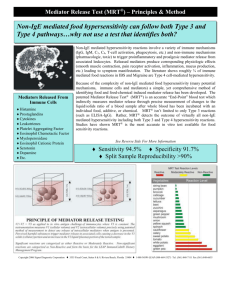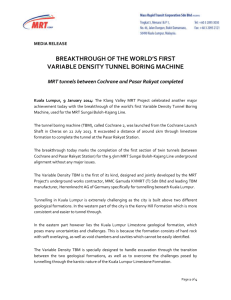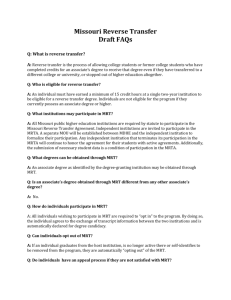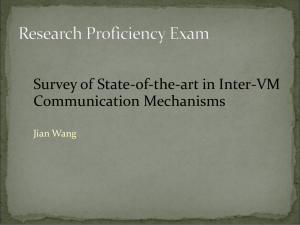PPTX
advertisement
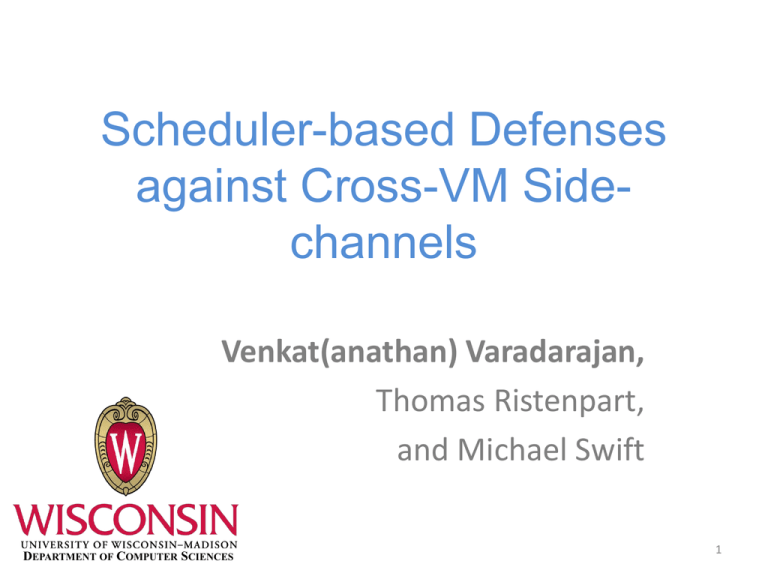
Scheduler-based Defenses
against Cross-VM Sidechannels
Venkat(anathan) Varadarajan,
Thomas Ristenpart,
and Michael Swift
DEPARTMENT OF COMPUTER SCIENCES
1
VMM
Public Clouds (EC2, Azure,
Rackspace, …)
Multi-tenancy
Different customers’
virtual machines (VMs)
share same server
VM
VMM
VM
VM
VM
VMM
VMM
VMM
VM
VM
VM
VM
VM
Benefits:
1. High resource utilization,
2. Low service cost
2
Shared Resources and Isolation
VM
(m-VCPUs)
VM
(m-VCPUs)
VM
(m-VCPUs)
Hypervisor
Core
Core
Private Caches
Private Caches
Branch Predictor
VM
(m-VCPUs)
VM
(m-VCPUs)
via per-core sharing
[Zhang et al’12, Ristenpart al’09]
Core
Private Caches
BranchviaPredictor
Branch Predictor
system-level sharing
[Yarom & Falkner’14, Varadarajan et al’12]
System shared resources (LLC, memory, disk, n/w etc.)
3
Problem: Cache-based Side*
Prime channels
Probe
C
_F
(s):
RYPTO
Core:
A
V
VM
Secret
UNCTION
s secret bit
A
Time
VM
I-cache
cache sets
if (s = 0) {
OPERATION_A
}
if (s = 1) {
OPERATION_B
}
Attacker Timing
Profile
cache ways
*Zhang, Juels, Reiter, Ristenpart, “Cross-VM Side-channels …”, CCS’12
Extract secret
information
4
Requirements for Successful SideSecret
channel
Prime
Probe
C
_F
(s):
RYPTO
Core:
A
V
s secret bit
A
VM
UNCTION
Time
VM
I-cache
quick
preemption
shared
resource
cache sets
if (s = 0) {
OPERATION_A
}
if (s = 1) {
OPERATION_B
}
Attacker Timing
Profile
high-precision
timer
cache ways
*Zhang, Juels, Reiter, Ristenpart, “Cross-VM Side-channels …”, CCS’12
Extract secret
information
5
Defenses against Side-channels
1. Sharing
– Resource Partitioning [NoHype’10]
– Specialized Hardware [RPcache’07]
– Software-based partitioning [StealthMem’12]
2. Access to high-resolution timers
– Reduce resolution [TimeWarp’12]
– Removing timing channel [StopWatch’13]
No countermeasures deployed by providers!
3. Quick cross-VM preemptions
– No prior work!
6
Our Solution: Soft Isolation
Allow sharing but limit frequency of
dangerous VM interactions
Goals:
1. Secure: Controlled information leakage
2. Commodity: Easy to adopt
3. Efficient: Allow sharing, low overhead
VM
VM
Hypervisor
Core
Private Caches
(per core state)
… with simple changes to Hypervisor’s CPU scheduler
7
Rest of the talk …
1. Background: Quick Preemptions & Schedulers
1. Soft-Isolation: Scheduler-based defense
1. Evaluation: Security and Performance
8
Requirement for Quick
Preemptions
Prime
Probe
C
_F
RYPTO
Core:
V
A
s secret bit
V V A
VM
Time
VM
Preemption
Interval
cache sets
UNCTION(s):
if (s = 0) {
OPERATION_A
}
if (s = 1) {
OPERATION_B
}
Next subsequent code/task
execution … (or noise)
Rate of preemption
cache ways> Rate of event to measure
9
Why do schedulers allow quick
preemptions?
Batch VMs
Interactive VMs
Throughputoriented:
Benefits from longer
scheduler timeslices
Latency-oriented:
Benefits from quick
wakeups ,
BOOST priority
…
State-of-art
CPU schedulers
Prime-probe attacker:
Abuses BOOST priority,
using interrupts.
Malicious
VM
Core:
V
A
V
A
Time
< 10µs
10
Soft-Isolation: Ratelimit
Preemptions
Core:
V V A
Interrupt
(boosted)
V
A
VM
Time
VM
Min. runtime
(scheduler parameter)
Available in Xen (and KVM)
• ratelimit_us (and sched_min_granularity_ns)
• Reduces VM-switches Boosts batch-workload’s performance
Minimum RunTime (MRT) guarantee soft-isolation
11
MRT Guarantee and Open
Questions
1. Can MRT defend against
Cross-VM Side-channels?
(security evaluation)
MRT value
Core:
V
delay
A
V
Time
2. Trade-off between security
and performance?
(performance overhead)
12
Experimental Methodology
VM
Two VMs:
1. Attacker
2. Victim
VM
Hypervisor
Core
Setting similar to public clouds (e.g. EC2)
Xen Configuration
Machine Configuration
Xen Version
4.2.1
Scheduler
Credit Scheduler 1
Configuration
(Non-work conserving)
40% cap on DomU VCPUs
with equal weight
# VMs
6
# VCPUs per VM
2
Machine
Intel Xeon E5645, 2.4GHz, 6
cores, single package
Memory
Hierarchy
Private 32KB L1 (I- and DCache), 256KB unified L2,
12MB shared L3 & 16GB
DDR3 RAM.
13
Security Evaluation :
Prime-Probe Timing Profile
i-cache access timing
Idle Victim VM
Alternating usage pattern
Simple Victim VM
Under Zero-MRT
14
Security Evaluation :
Prime-Probe Timing Profile
Side-channel not discernible
Simple Victim VM
Under 1ms MRT
Alternating usage pattern
Simple Victim VM
Under Zero-MRT
15
Security Evaluation:
ElGamal Victim
ElGamal Side-channel require multiple preemptions within
single iteration for noise-reduction [Zhang et al’12]
Minimum number of iterations per preemption
800
728
700
600
500
386
400
300
200
100
0
155
Avg: 0.096 ops
0
4
0
0.1
32
0.5
68
1
2
Xen MRT (ms)
5
SQUAREMULT(x, e, N):
Let en , ..., e1 be the bits of e
y←1
for i = n down to 1 do
y ← SQUARE(y)
y ← MODREDUCE(y, N)
if ei = 1 then
y ← MULT(y, x)
y ← MODREDUCE(y, N)
end if
end for
return y
10
16
MRT Guarantee and Open
Questions
1. Can MRT defend against
Cross-VM Side-channels?
(security evaluation)
Core:
V
delay
A
V
Time
2. Trade-off between security
and performance?
(performance overhead)
17
Performance Evaluation:
Overall System Performance
Measured workload:
1. Interactive memcached,
cassandra, etc. and
2. Batch graph500, specJBB, etc.
Competing workloads:
microbenchmarks highly
cache-thrashing + (interactive or batch)
workload-mix
VCPU
VCPU
VCPU
VCPU
VCPU
VCPU
Hypervisor
Core
Core
Core
Core
18
Performance Evaluation:
Overall System Performance
Normalized to Zero-MRT
All-Batch
2
1.8
1.6
1.4
1.2
1
0.8
0.6
0.4
0.2
0
All-Interactive
Interactive-Batch
< 7%
overhead
Avg. 95th Percentile Latency
(interactive workloads)
Idle
At 5ms MRT
Avg. Runtime
(batch workloads)
19
More details in the paper …
• Per-core State-Cleansing
– Interactive VMs may still leak information
– MRT + State-cleansing incur low overhead
• Detailed Performance and Security Analysis
– 20+ graphs in the paper
It is cheap and easy to deploy!
20
Conclusion
5ms MRT + selective state-cleansing
- known attacks no longer work
- negligible overhead
- easy to adopt
Introduce new scheduler principle
- soft-isolation = allow sharing + limit dangerous
cross-VM interactions
https://bitbucket.org/vvaradarajan/robsched
contact: venkatv@cs.wisc.edu
21

